Jun 24, 2012
Science held hostage in climate debate
Garth Paltridge
The broad theory of man-made global warming is acceptable in the purely qualitative sense. If humans continue to fill the atmosphere with carbon dioxide, there can be little doubt that the average temperature of the world will increase above what it would have been otherwise. The argument about the science is, and always has been, whether the increase would be big enough to be noticed among all the other natural variations of climate. The economic and social argument is whether the increase, even if it were noticeable, would change the overall welfare of mankind for the worse.
Attempts to resolve the arguments are plagued with problems, a lot of which are inherently insoluble. There are many aspects of the behaviour of the natural climate system and of human society that are unpredictable in principle, let alone in practice. But perhaps the biggest of the underlying problems, and it is common to both arguments since it inevitably exists when there is large unpredictability and uncertainty, is the presence of strong forces encouraging public overstatement and a belief in worst-case scenarios.
From the social and economic side of things, one might take much more notice of the global warming scare campaign if it were not so obvious that many of its most vociferous supporters have other agendas. There are those, for instance, who are concerned with preservation of the world’s resources of coal and oil for the benefit of future generations. There are those who, like the former president of France, Jacques Chirac, speaking at a conference on the Kyoto protocol in 2000, look with favour on the possibility of an international decarbonisation regime because it would be a first step to global governance (the president’s actual words were “For the first time, humanity is instituting a genuine instrument of global governance”.) There are those who, like the socialists of the 20th century, see international action as a means to force a redistribution of wealth both within and between the individual nations. There are those who regard the whole business mainly as a path to the sort of influence which, until now, has been wielded only by the major religions. More generally, there are those who, like the politically correct everywhere, are driven by a need for public expression of their own virtue.
Of course there is nothing wrong, or at least not much that is wrong, with the ideals behind any of the above agendas except perhaps the last couple on the list. But the battles over them should be fought in the open and on their own merits rather than on the basis of a global warming crusade whose legitimacy is founded on still-doubtful science and on massive slabs of politically correct propaganda.
It is generally assumed that climate scientists themselves are more or less united on the matter and are not pushing a global warming barrow because of their interest in some other agenda. Certainly this is the story the activists would have us believe.
To the extent that there is such a thing as normal science, it relies upon accurate observations to verify its theories. Accurate is the operative word here. Climate research has to rely on spectacularly inaccurate data from information on Earth’s past climate. Even though there are vast amounts of atmospheric and oceanographic data to play with, together with lots of proxy information from tree rings and ice cores and corals and so on, abstracting a coherent story from it all is something of a statistical nightmare. It gives a whole new meaning to the old saying “lies, damn lies and statistics”.
Suffice it to say that climate science is an example of what Canadian educator Sue McGregor calls “post-normal science”, in which “the facts are uncertain, values are in dispute, stakes are high and decisions are urgent”. In such circumstances it is virtually impossible to avoid subconscious cherry-picking of data to suit the popular theory of the time. Even Isaac Newton and Albert Einstein were not immune from the problem. In their case they were of sufficient genius (and were sufficiently lucky!) for their theories ultimately to trump the inaccuracy of the observations they had selected. Other scientists are rarely so prescient or so lucky. In the modern era, the problem is compounded by the existence of vastly complex computer models that can be tuned, again more-or-less subconsciously, to yield the desired result. From theory to observation and back again - if we are not careful, the cherry-picking can go round and round in an endless, misleading loop.
But the real worry with climate research is that it is on the very edge of what is called postmodern science. This is a counterpart of the relativist world of postmodern art and design. It is a much more dangerous beast, whose results are valid only in the context of society’s beliefs and where the very existence of scientific truth can be denied. Postmodern science envisages a sort of political nirvana in which scientific theory and results can be consciously and legitimately manipulated to suit either the dictates of political correctness or the policies of the government of the day.
There is little doubt that some players in the climate game - not a lot, but enough to have severely damaged the reputation of climate scientists in general - have stepped across the boundary into postmodern science. The Climategate scandal of 2009, wherein thousands of emails were leaked from the Climate Research Unit of the University of East Anglia in England, showed that certain senior members of the research community were, and presumably still are, quite capable of deliberately selecting data in order to overstate the evidence for dangerous climate change. The emails showed as well that these senior members were quite happy to discuss ways and means of controlling the research journals so as to deny publication of any material that goes against the orthodox dogma. The ways and means included the sacking of recalcitrant editors.
Whatever the reason, it is indeed vastly more difficult to publish results in climate research journals if they run against the tide of politically correct opinion. Which is why most of the sceptic literature on the subject has been forced onto the web, and particularly onto web-logs devoted to the sceptic view of things. Which, in turn, is why the more fanatical of the believers in anthropogenic global warming insist that only peer-reviewed literature should be accepted as an indication of the real state of affairs. They argue that the sceptic web-logs should never be taken seriously by “real” scientists, and certainly should never be quoted. Which is a great pity. Some of the sceptics are extremely productive as far as critical analysis of climate science is concerned. Names like Judith Curry (chair of the School of Earth and Atmospheric Sciences at the Georgia Institute of Technology in Atlanta), Steve McIntyre (a Canadian geologist-statistician) and blogger Willis Eschenbach come to mind. These three in particular provide a balance and maturity in public discussion that puts many players in the global warming movement to shame, and as a consequence their outreach to the scientifically inclined general public is highly effective. Their output, together with that of other sceptics on the web, is fast becoming a practical and stringent substitute for peer review.
Climate science has transformed itself from a research backwater a few decades ago into one of the greatest public-good scientific cash cows ever devised. In Australia, for instance, there is a separate federal Department of Climate Change and Energy Efficiency specifically devoted to implementing (buying?) the social change required to limit global warming. The livelihood of many of the climate scientists within the CSIRO and elsewhere is now dependent on grants from that department. It is not a situation conducive to sceptical outlook and balanced advice. When a tendency toward postmodern science is mixed with a single, generous and undoubtedly biased source of money, it is not surprising that things can go very wrong very quickly.
This has all come about largely because government laboratories these days are required to earn a goodly fraction of their operating income from external sources - this even when their activity is public-good research for which there is not a private market. The requirement inevitably encourages the emergence of activist-scientists who are not overly concerned about sliding into the realm of postmodern science.
In the particular case of CSIRO for instance, the encouragement starts with a formal mission statement to the effect that CSIRO seeks to achieve “a profound and positive impact on the most significant challenges and opportunities facing Australia and humanity”. Good stirring stuff of course, except that “impact” can get translated to “influence” in the reviews of its scientific programs, and the mission statement can be interpreted as justification for devoting a large fraction of overall scientific resources to the business of creating a market for one’s scientific advice.
As one organisation after another jumps, or is pushed, into producing public assessments of the climate change issue, we see the same small group of activist-scientists in the background. We see them providing briefings to federal and state politicians. We see them as primary advisers to supposedly independent organisations such as the Australian Academy of Science. We see them involved in programs to introduce school children to the dangers of a carbon footprint. Generally we see them in what agricultural science used to call extension activities - although in the case of climate change much of the extension effort is devoted to convincing the various audiences that there is indeed a problem worth doing something about.
No doubt these scientists genuinely believe in their own perception of the climate change story. But why do mainstream scientists go along with the inevitable overstatement associated with the activism business?
One factor is a form of loyalty to colleagues. Another, bearing in mind the singular nature of the funding source, is the need to eat. But mostly it gets back to the uncertainty of the science. The typical climate researcher is reluctant to go public with contrary opinion not backed by something very close to real proof. And there is very little real proof on either side of the climate change story. Contrary opinion in an era where postmodern science is almost respectable can be dangerous to a research career.
The bottom line of all this is that deliberate understatement of the uncertainty of the science allows overstatement of the climate change problem. In the early days of the debate - back in the ‘70s and early ‘80s, before the whole issue became highly politicised - scientists were quite happy to admit to the uncertainty.
As a consequence, there was a philosophy around the traps at the time to the effect that, if nations really wanted to do something drastic and expensive about global warming, then the sensible course would be to take only those actions which would also be worth doing for other reasons. Improving the efficiency of transport would be sensible for instance. Burying vast quantities of carbon from the smokestacks of power stations would not.
That philosophy soon got lost in the politics. It is mildly encouraging now, perhaps as a result of the Climategate scandal, that we are beginning to see a new generation of climate scientists look again with a properly jaundiced eye at the question of uncertainty and how it might be assessed.
It is not surprising that society’s opinion on what to do about climate change is highly polarised. There are passionate and vocal supporters on both sides of the argument as to whether global warming will be disastrous.
It is a bit surprising that what seems to be a roughly 50/50 split of public opinion is not at all a reflection of the much vaunted consensus of the climate science community. Perhaps this says a lot for the commonsense of the person in the street. In any event, the complexity of the issue, and the vast scale of the resources required to solve the problem (if there is a problem), make it difficult for middle-ground argument to be heard.
All of which makes it very hard for politicians to make sensible decisions on the basis of some reasonable balance of probability. One can but wonder at the prescience of former US president Dwight D Eisenhower in his farewell address to the nation in 1961:
“Yet, in holding scientific research and discovery in respect, as we should, we must also be alert to the equal and opposite danger that public policy could itself become the captive of a scientific-technological elite.”
Suffice it to say that there is a need for politicians to have access to a real diversity of advice on the science of climate change. In this country, and in most Western countries, the sources of advice are highly inbred.
It would seem important also that any political and economic action on the matter of global warming should be flexible enough to be changed, or indeed discarded, should there be a significant shift in scientific or public perception. In terms of practical politics, the government of the day needs to give itself future wiggle room by making it clear to everyone that it is indeed making decisions on the basis of a fluid balance of probabilities, rather than on what activists insist is a scientific and economic certainty.
Garth Paltridge is an emeritus professor with the University of Tasmania, a visiting fellow at the Research School of Biology at the Australian National University and a fellow of the Australian Academy of Science. He is the author of The Climate Caper: facts and fallacies of global warming, Connor Court, 2009. He was a chief research scientist with the CSIRO division of atmospheric research.
The Australian Financial Review
-----------------
Obama’s Hope ... And Climate Change
Investor’s Business Daily
Election ‘12: President Obama plans to make climate change his top priority for his second term. No, that’s not from The Onion, a humor publication, but the left-leaning New Yorker. What planet does this president live on?
‘Obama has an ambitious second-term agenda,” wrote Ryan Lizza in this week’s New Yorker. “The President has said that the most important policy he could address in his second term is climate change,” supposedly to “improve the world.”
So forget about the abysmal jobless numbers above 8% for over three years, or the $15 trillion deficit that threatens to turn the U.S. into Greece. No, amid those very real calamities, climate change is more important.
If this isn’t a sign of a president out of touch with reality, what is? If climate change is Obama’s “most important” policy issue, then neither the Tea-Party-led victories around fiscal discipline - such as the Wisconsin vote, nor the West Virginia primary, here 40% of Democrats chose a jailbird to protest Obama’s anti-coal agenda, made a dent on him.
Like a madman doing the same thing over and over again and expecting a different result, it can only mean Obama intends to double-down on his green agenda if re-elected.
Already no president has ever spent money on “climate change” as he has. The Congressional Budget Office reports that since 1998, $99 billion has been spent among 14 agencies on “climate change.” Of that, $35 billion was earmarked from the 2009 stimulus.

The top agency charged with enacting the Obama green agenda - the Department of Energy - has seen its budget soar from $24 billion in 2009 to $38 billion in 2012, the Office of Management and Budget estimates.
But the public doesn’t share the love.
Poll after poll since 2009 shows the public considers climate change dead last in importance. In 2012, Pew Research Center reported that 86% of the public considered the economy a top priority, and 82% considered jobs in that slot. Global warming ranked dead last at 25% - and that represented a 13% decline from 2007.
The issue failed even among environmentalists, according to a 2011 Gallup poll, who ranked global warming dead last at 51% in a 2011 poll of concerns.
That coincides well with the fact that climate change is rapidly being exposed as junk science - glaciers aren’t melting as claimed, but data are being fudged and contradictory findings repressed in multiple incidents.
Has Obama learned nothing? The economy topped the voters’ list of concerns in 2009, but Obama bulled ahead with health care reform anyway. Now this.
The one thing that can be concluded from this policy priority is that on the environment, Obama is planning more of the same - and the voters be damned.
---------------
And Obama’s henchman are at work selling the big lie:
Dem senator: ‘Bogus’ to say humans not causing climate change
By Pete Kasperowicz
Sen. Sheldon Whitehouse (D-R.I.) said on the Senate floor Thursday that the debate over whether humans are causing climate change is over, and that it has been shown conclusively that human activity is leading to global warming.
“People say there are questions about the theory,” he said. “No, there are not.
“The argument that the jury is still out on climate change is a false and bogus argument,” he added. “The jury is not out. In fact, the jury is in, the effects are obvious, they surround us every day, and we need to take action.”
Read more on The Hill’s E2 Wire blog.
Jun 22, 2012
Lord Monckton Reports From Rio
From Christopher Monckton of Brenchley in Rio de Janeiro
Source: SPPI
MAD GIG
To the Gaia-worshipers in Rio, all is symbolic of the new religion
Symbolism! Dontcha just love it? Even the three-letter abbreviations for the world’s airports convey a resonant message for the goofy Gaia-worshipers here in Rio de Janeiro for the conference on “sustainable development” (whatever that may mean). Flights still follow the old colonial patterns, so it is easier to fly to Rio (GIG from Madrid (MAD) than from London. Entertainingly, the bag-tag on my suitcase bore the legend MAD GIG - a deftly synoptic description of the leftfest on Brazil’s once-fashionable coast.
The intended triumph of the new religion over the old was symbolized by a light-emitting diode system costing hundreds of thousands of dollars that has turned the normal floodlighting of the towering statue of Christ the Redeemer an unpleasant, lurid green, so that He looks like a giant jelly-bean. Fortunately, Divine intervention (or perhaps the Gore effect) has smothered the volcanic pinnacle on which the statue stands in unseasonably dense cloud and pouring rain, rendering this crude but costly sacrilege altogether invisible. Chalk up ten points to the old religion. God is not mocked.
Soldiers with sub-machine-guns and - for some reason - elephant guns are guarding this extravagantly expensive and contemptibly childish propaganda gesture to make sure no one symbolically reasserts the triumph of the Resurrection by cutting off the unnatural green glow and replacing it with the traditional, glorious white.
The rubbish that litters the streets and even the once-pristine beaches of Copacabana and Ipanema is surely a symbol for the garbage that will soon emerge from the negotiations. One can be confident that it will be garbage, because this year, for the first time, the UN has gone to unprecedented lengths to make sure that no one gets daily-updated versions of the central negotiating text. If somebody hides something, it is because somebody has something to hide.
In a maneuver symbolic of the intended global dictatorship that is the ever-more-openly declared ambition of the world-government wannabes of the UN and of a governing class that has grown impatient of democracy and contemptuous of the mere people, the supposedly “transparent” pointy-heads’ conference has been ruthlessly divided into three entirely separate pointy-heads’ conferences.
First, symbolic of the grim Communism that will be the ideological mainspring of the exciting, shiny, new dictatorship for which the UN longs, and for which its senior strategists planned at a meeting this time last year at which Secretary-General Ban Ki-Moon called for suggestions to put an end to national sovereignty (and hence to democracy), the exhibition area which in earlier UN conferences was adjacent to the main hall where the plenary negotiating sessions took place was set up several miles away in a tent city revealingly called the “People’s Congress”.
Secondly, as a symbol of the permanent imprisonment of just about everybody that Ban Ki-Moon’s corrupt, totalitarian world government will bring about, the non-government organizations accredited to the UN were corralled in the filthy, soulless, crumbling Rio Centro conference center, where hundreds of armed, sharp-suited UN goons kept them determinedly away from the vast concrete bunker where the actual negotiations were taking place.
Thirdly, to symbolize the total separation of the governing class from the governed that will become the norm as the UN takes power, the governmental delegates, traveling in a thousand-strong fleet of gas-guzzling, carbon-emitting limousines escorted by secret police on Harley-clone motorcycles, have been kept in near-total isolation from the non-government organizations and from the mere people.
“Secondary passes” allowing limited access to the plenary sessions are handed out only to those whom the UN can absolutely rely upon not to raise any questions at all about what is going on. The world’s mainstream news media have access, of course: these days they can be trusted to treat all the works of the UN with incurious, unquestioning, head-banging acquiescence.
After I had dined with a direct descendant of the Emperor of Brazil at a fashionable restaurant a couple of nights ago, a cavalcade (or cortege) drew up at the porte-cochere. First came a clattering Harley clone; then two SUVs full of UN goons; then a black VIP limo containing the dictator of Rwanda and his minders, then several more wagonloads of goons, then two more motor-cycles. One of the goons quite unnecessarily shoved me aside with a curse, symbolic of the New World Order where They give the orders and we get pushed around. Fortunately I can hit back. I shall cross the dictator off my Christmas-card list. So there.
So, what are They up to at this conference? The pre-conference draft of the negotiating text contained all the usual meaningless drivel about “sustainable development”, women’s rights and gender equality, rights of indigenous people to enjoy racial discrimination in their favor (there were several baffled Red Indians (er, sorry, “Native Americans") wearing traditional feathered headdresses stumbling around the drafty concrete chambers of the conference center), the need to cut the world’s population down to size, and other traditional demands of the hard Left.
One of a series of badly-drawn but prominently-displayed posters by propagandized children showed the Sun dressed as a doctor diagnosing the Earth’s disease: “I’m afraid you’ve got humans.” In the UK it is illegal to indoctrinate children in this way, which is how we were able to defeat Al Gore in the High Court five years ago on the ground that his sci-fi comedy horror movie was political propaganda and not science.
So why the obsessive secrecy? Why are the national negotiators kept away from the non-government organizations that have always had access to them until now? Why are the updated negotiating texts not made available? One reason stands out. The UN knows perfectly well that if the people knew what was being inserted into the generally anodyne negotiating text they would not stand for it.
An example. Last year, at the Durban climate conference, I obtained a copy of the negotiating text, summarized it, and posted up the summary at WattsUpWithThat. A couple of days later WordPress, which hosts half a million blog postings every day, got in touch to say that that posting had attracted more hits than any other that day. Why were people so interested? Because not one of the thousands of journalists in Durban had bothered to report what was actually in the negotiating text.
My report revealed that the climate conference was proposing to grant Mother Earth the right to sue any Western nation in a new International Climate Court, and to cut CO2 concentration by half, extinguishing most plant and animal species on Earth. The disastrous publicity arising from these revelations led the UN to abandon fully half of the Durban negotiating text within 24 hours of my revealing its contents.
The UN was determined not to suffer this humiliation again. So it has ensured that the pre-conference draft contains so little of interest that even Greenpeace has condemned the UN for not going far enough. Instead, all the really damaging material has been kept secret. No doubt it will be inserted into the text during the negotiations. It will then be presented as a fait accompli after the usual all-night session, and the world’s media will dutifully congratulate the negotiators on a job well done.
A senior UN official to whom I spoke said that the organization had now become so corrupt that a number of sexual and financial scandals had occurred at the headquarters building in New York. The UN, he said, was hushing them up by not reporting them to the police authorities in New York as protocol demanded. He said that the revelation of the contents of the updated Durban negotiating texts had led to a major rethink within the UN, which had decided to set up the elaborate pantomime that I have described, preventing any but a carefully-selected few from getting alongside the negotiators.
“Transparency?” he snorted. “Not under Ban Ki-Moon. Everything is now hidden - and the UN has a great deal to hide. But don’t quote my name - these people are vindictive.”
As I said at a press conference here, the UN has outlived its usefulness and should now be brought to an end. Everything it does could be better done, at far less political and financial cost, by individual nations cutting out the predatory UN middlemen.
The UN has had its day. Time to abolish it, in an act symbolic of the freedom and democracy that we, the people, intend to keep for ourselves whether the dictators-in-waiting and their fawning lickspittles in the mainstream news media like it or not.
Jun 21, 2012
Rio+20 is greatest threat to biodiversity
Paul Driessen and David Rothbard
99% of species and humans are ill served by the 0.1% UN and environmentalist elites
The UN Conference on Sustainable Development is underway in Rio de Janeiro. This time, 20 years after the original 1992 Rio “Earth Summit,” thousands of politicians, bureaucrats and environmental activists are toning down references to “dangerous man-made climate change,” to avoid repeating the acrimony and failures that characterized its recent climate conferences in Copenhagen, Cancun and Durban.
Instead, “Rio+20” is trying to shift attention to “biodiversity” and alleged threats to plant and animal species, as the new “greatest threat “ facing Planet Earth. This rebranding is “by design,” according to conference organizers, who say sustainable development and biodiversity is an “easier sell” these days than climate change: a simpler path to advance the same radical goals.
Those goals include expanded powers and budgets for the United Nations, UN Environment Programme, US Environmental Protection Agency and other government agencies, and their allied Green pressure groups; new taxes on international financial transactions (to ensure perpetual independent funding for the UN and UNEP); and more mandates and money for “clean, green, renewable” energy.
Their wish list also includes myriad opportunities to delay, prevent and control energy and economic development, hydrocarbon use, logging, farming, family size, and the right of individual countries, states, communities and families to make and regulate their own development and economic decisions.
Aside from not giving increased power to unelected and unaccountable bureaucrats and activists, there are two major reasons for stopping this attempted biodiversity-based power grab.
1) There is no scientific basis for claims that hundreds or thousands of species are at risk. Up to half of all species could go extinct by 2100, asserts astronomer and global warming alarmist James Hansen, because of climate change, “unsustainable” hydrocarbon use, human population growth and economic development. At Rio+20 activists are trumpeting these hysterical claims in reports, speeches and press releases. Fortunately, there is no factual basis for them.
Of 191 bird and mammal species recorded as having gone extinct since 1500, 95% were on islands, where humans and human-introduced predators and diseases wrought the destruction, notes ecology researcher Dr. Craig Loehle. On continents, only six birds and three mammals were driven to extinction, and no bird or mammal species in recorded history is known to have gone extinct due to climate change.
The massive species losses claimed by Hansen, Greenpeace, WWF and others are based on extrapolations from the island extinction rates. Some are just wild guesses or rank fear-mongering, with nothing remotely approximating scientific analysis. Other extrapolations are based on unfounded presumptions about species susceptibility to long or short term climate shifts - fed into clumsy, simplistic, nonvalidated virtual reality computer models that assume rising carbon dioxide levels will raise planetary temperatures so high that plants, habitats, and thus birds, reptiles and animals will somehow be exterminated. There is no evidence to support any of these extinction scenarios.
Indeed, there is no empirical evidence to support claims that average global temperatures have risen since 1998, or that we face any of the manmade global warming or climate change cataclysms proclaimed by Hansen, Gore and others.
2) The greatest threats to species are the very policies and programs being advocated in Rio. Those policies would ban fossil fuels, greatly increase renewable energy use, reduce jobs and living standards in rich nations, and perpetuate poverty, disease, death and desperation in poor countries.
Today, over 1.5 billion people still do not have electricity, or have it only a few hours each day or week. Almost 2.5 billion people live on less than $2 a day. Millions die every year from diseases that would be largely eradicated by access to reliable, affordable electricity for cooking and refrigeration, clinics and hospitals, clean water, sanitation, and businesses and industries that generate jobs, prosperity and health. Opposition to large-scale electricity generation forces people to rely on open fires for cooking and heating
- perpetuating lung diseases and premature death, from breathing smoke and pollutants. It also destroys gorilla and other wildlife habitats, as people cut trees and brush for firewood and charcoal.
Wind turbines slice up birds and collapse bat lungs, exacting an unsustainable toll on eagles, hawks, falcons, and other rare, threatened and endangered flying creatures.
Turbine and solar arrays cover and disrupt millions of acres of farmland and wildlife habitat, to provide expensive, intermittent power for urban areas. They require backup generators and long transmission lines, and consume millions of tons of concrete, steel, copper, fiberglass, polymers and rare earth minerals - extracted from the Earth, often in countries whose pollution control regulations and technologies are substantially below US, Canadian, European and Australian standards.
Corn-based ethanol requires tens of millions of acres, billions of gallons of water, millions of tons of fertilizer and insecticides, and enormous quantities of hydrocarbon fuels.
And yet, President Obama told Ghanaians in 2010 that poor, electricity-deprived, malnourished Africans should rely on biofuel, wind and solar power - and not build even gas-fired power plants.
Hunting, subsistence living and poverty are among the greatest risks to species. Denying poor families access to reliable, affordable electricity is a crime against humanity
The Rio+20 biodiversity and sustainability agenda means artificially reduced energy and economic development. It means rationed resources, sustained poverty and disease, and unsustainable inequality, resentment, conflict, and pressure on wildlife and their habitats.
Simply put, 99% of humans and wild kingdom species are being ill served by the 0.1% UN and environmentalist elites gathered in Brazil, and purporting to speak for mankind and planet. Our Creator has endowed us with a world rich in resources, and even richer in intelligent, hard-working, creative people who yearn to improve their lives and be better stewards of our lands, resources and wildlife. The primary obstacles to achieving these dreams are the false ideologies, anti-development agendas and suffocating regulations being promoted at the Rio+20 Summit. If we can eliminate those obstacles, the world will enjoy a rebirth of freedom and opportunity, voluntarily stable populations, and vastly improved health, welfare and justice for billions. We will also bring far greater security to Earth’s wondrous multitudes of wild and scenic areas, and plant and animal species.That would be an enormous gain for our planet and people.
__________
Paul Driessen is senior policy advisor for the Washington, DC-based Committee For A Constructive Tomorrow (www.CFACT.org) and author of Eco-Imperialism: Green power - Black death; David Rothbard serves as CFACT’s president.
See more on Earth Summit Babble by Alan Caruba here.
Jun 13, 2012
Israeli professor says global warming caused by sun, not man
By Danny Bloom
CHIAYI CITY, Taiwan - After I wrote a commentary on June 3, 2012 about global warming and climate change and what all this might mean for the future existence of Israel as a state in the arid Middle East, an Israeli scientist that I contacted told me that he thought I was barking up the wrong tree and was wrong about global warming. This led to what, for me, was a fascinating e-dialogue.
I met Professor Emeritus Giora Shaviv, the Swartzmann-Medvedi chair in Space Sciences at The Technion in Haifa after coming across a 2009 news article in the Jewish Chronicle in London headlined “Israeli scientist denies global warming.”
Although Dr Shaviv and I don’t see eye to eye on this, I wanted to find out more about his ideas and climate views, after reading this opening lines of the London story: “A leading Israeli scientist has renounced the concept of man-made global warming at a lecture given to the British Technion Society, just days before world leaders meet to discuss ways to halt it. Professor Giora Shaviv professor of physics at the Technion, claimed that the accepted level of carbon dioxide in the air is wildly exaggerated.”
“Dr Shaviv said that though for years the Intergovernmental Panel on Climate Change (IPCC) has claimed that an increase in carbon dioxide has led to an increase in temperature, in fact, the reverse is correct. He argued that the movement of the sun affects temperature, which influences the levels of carbon dioxide, and that these levels have risen and fallen for centuries, even before mankind.”
Then came the clinker: “CO2 is not responsible for heating the earth, the cause is the activity of the sun which we cannot control,” Dr Shaviv said.
And one British defender of Dr. Shaviv’s views was quoted as saying:"There is a hysteria and exaggeration of the issue with people worrying that the end is nigh. People need to calm down. The reality is we haven’t got a clear idea what the climate is doing.”
So, having read all this, I emailed Dr Shaviv in Israel and in Internet time, received a reply from him and we later exchanged a few more cordial and friendly messages back and forth. He knows that I feel that global warming maybe very well spell the end of the human species in the next 500 years, if we do not halt CO2 emissions worldwide. And I know that he disgress with me.
“Dear Danny,” Professor Shaviv wrote to me, when I asked him about global warming, “I did not deny the possibility of global warming in that 2009 article you read online. I argue that
a) If at all, it is not man made, b) It is due to solar activity, c) The effect is much smaller than claimed, and d) It is periodic and warming and cooling happened in the past before the industrial revolution and when there were no humans around.”
When I asked Dr Shaviv what his opinion of climate activist Al Gore, he told me: “Al Gore is an idiot who does not know what he is talking about. He shows two graphs and hides the third one. Moreover, there is evidence that temperature rise preceded the CO2 rise (long before the industrial revolution) so that the cause and effect that Al Gore claims is completely wrong.”
When I asked Dr Shaviv what he thought about my ideas on climate change, especially about the possibility that the very future of Isreal could be at stake within the next 500 years if climate change is not halted, he replied: “I see your points, Danny, and I remain calm. The sun will take care of it.”
What Dr Shaviv was getting at was this: He believes that the sun is most responsible for the flucuations on the Earth’s temperature over millions of years and that global warming is caused by the sun even now, and is not caused by humans or the industrial output of carbon dioxide emissions or cars or India’s and China’s coal burning factories. He believes the sun will take care of eveything and that Al Gore is very very wrong about almost everything.
So we agreed to disagree, and remain online friends. I appreciated his candor in replying to my emails.
Meanwhile a headline on the Climate Depot website extrapolated from my concern for Israel’s future existence that I was acusing climate skeptics of anti-semitism, I simply do not understand how the editor of that site could twist my op-ed about the future of Israel’s existence into that. It just does not compute at all.
But as the climate wars heat up, the language is going to heat up too, and we must all be on guard against twisting the words of our opponents into false accusations.
Bloom is Taiwan bureau chief and cyber-surfer in chief for San Diego Jewish World.
Note Giora’s son is Professor Nir Shaviv who has shown how sun’s effects on cosmic rays was the driver for past warmings and glaciations.
Jun 09, 2012
Records and Extremes - Updated
By Joseph D’Aleo, CCM, AMS Fellow
Following the super La Nina of 2010/11, we had a period of extremes - snow and cold to start, then floods and drought, tornadoes and heat and a landfalling hurricane.
As the La Nina faded but the eastern and northern Pacific water remained cold, a warm and dry winter followed in 2011/12 much as the warm winter of 1918/19 followed the super La Nina of 1917/18 which was the only colder, snowier La Nina this century.
The warmth peaked in March. With the exception of the Pacific Northwest, most of the nation was well above normal with many daily record highs. Warmest March in the record books for the lower 48.
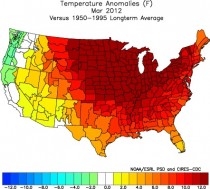
Enlarged
The warmth has continued but gradually subsided since then.
Despite the high number of record daily highs, this is a US centric warm event. The NCEP CFSv2 global anomalies from the winter through early June have been much of the time below the 1981-2010 average. The deep Eurasian cold wave shows in late January.
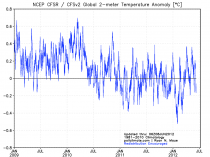
Enlarged
Looking back over the last century, you can explain global temperatures by ENSO and volcanism and the ocean multidecadal cycles that favor a particular ENSO state. Here is the plot since 1979 of all data sets with ENSO and volcanism indicated.
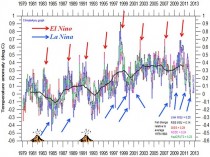
Enlarged
El Ninos bring a short term warming, La Ninas a dip in global temperatures. The warm mode of the Pacific from 1977 to 1998, led to a net warming. Major volcanoes produce a cooling as we saw in the early 1980s and early 1990s, lack of volcanism (like we have seen since the middle 1990s) means more solar radiation at the surface and enhanced warming.
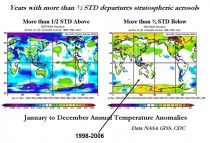
Enlarged
In 1995, the Atlantic went into its warm mode, which means a warmer annual temperature in the Northern Hemisphere.
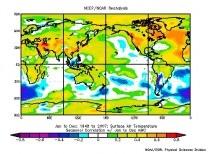
Enlarged
May for the US was warm again making the last year in the US allegedly the warmest in the record, but as John Christy of UAH noted from the satellite perspective, it was notable only in the lower 48 (see).
Again in the Pacific Northwest, it actually was colder than the 30 year mean for the fifth straight year.
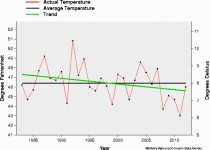
Enlarged
•Spring temperatures across the Northwest Region have been trending downward at a rate of 0.59 degrees F per decade during the 30 years since 1983.
•Spring temperatures across the Northwest Region have been trending downward at a rate of 4.10 degrees F per decade during the 10 years since 2003.
A Cold west usually translates to warmth further east as we saw in the 2010 and 2011 summers.
As hot as it has been the past two summers, the heat is not cracking all-time levels. Here is the latest decadal plot of all-time records for the 50 states. When multiple years are tied, the latest year/decade is used.

Enlarged
The 1930s stands out as the hottest decade, the 1910s and 1950s were second, 1990s third and 1980s fourth. This decade doesn’t rank although it is early.
All time cold records look like this.

Enlarged
New York City reached 100F last summer, but that was common from the 1930s to 1950s.

Enlarged
Oh by the way see how the 100 degree days compares with CO2.
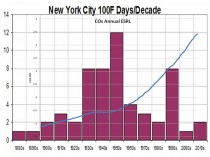
Enlarged
Here is Des Moines which has seen fewer and fewer 100F days in recent decades.

As Steve Goddard reports “During the 1930s, 100 degree days were very common in Des Moines. They very rarely happen any more. It has been nine years since Des Moines hit 100F. By contrast, 1934 had thirty-one days over 100 - including five days over 110 and three days over 112.”
The state monthly records through the end of the 2009.. This depicts the 12 monthly records for the 50 states (600 data points). There were likely March heat records set in some states and perhaps some other months so the 2010s will show and take away from some prior years.

Enlarged
See Bruce Hall’s 2010 guest post on Roger Pielke Sr.’s Climate Science here.
ICECAP NOTE: ICECAP was one of the earliest ‘realist’ climate blogs that provided insight into natural factors and challenged the orthodoxy. Your donations helped us maintain the site and provide some support for the time invested in keeping it updated. One or more posts have been added a day for going on 5 years now now totaling 6,082 entries. 305,205 have enrolled as members with a total of 32,446,550 page hits. All the posts are archived. We maintain them in the archives and have a good search tool. I maintain the site as best I can - maintaining a secure site with high traffic is expensive. You can help with even small donations - see the DONATE button left or email me at frostdoc@aol.com for an address to mail a check if you prefer not using PAYPAL. Rest assure, we have never had an issue with Paypal although they get a piece of any transaction. I have had at times had to subsidize the site from month to month. I don’t like having to ask people for donations but our side despite all the claims to the contrary is not subsidized/ endowed with money and grants like the alarmist blogs like RealClimaate and Climate Progress. You will never see them ask for donations. They get all they need from their liberal foundations and eco groups.
You can also help by buying books in the Amazon store and/or enrolling as a Premium member of Weatherbell.com, where I am co-chief meteorologist with Joe Bastardi. recently Dr. Ryan Maue from FSU has joined our staff and is helping us provide model based value-added output. He maintains and has published on the ACE index. We have a weather radio show on Sunday nights 8pm to 9:30pm EDT called Wise Guys of Weather Radio. On the Weatherbell site we have the premium blogs and specialized forecasts for energy, agriculture, marine, snow, insurance and other applications on the Commercial site. Joe B has also posted on Icecap. Both Icecap and Weatherbell are 7 day a week jobs. I have also PRO BONO helped produce documents for comments to the EPA that enabled lawyers to file a science based AMICUS brief that went to the DC courts to try and stop EPA deadly overregulation. Thank you for you support over the years. Joe D’Aleo and Art Horn
|















